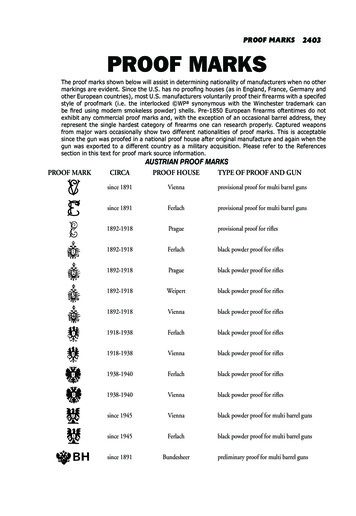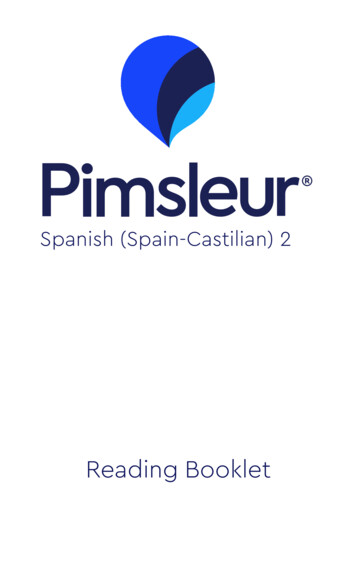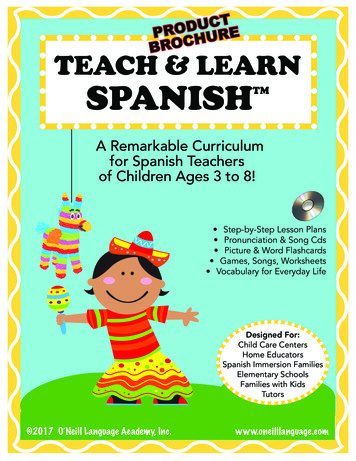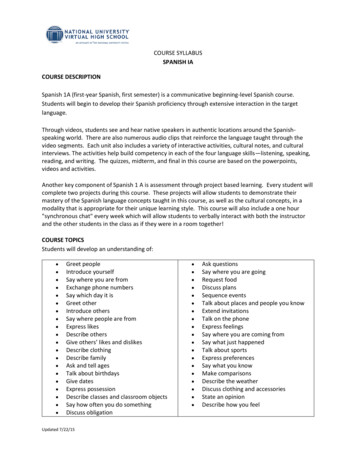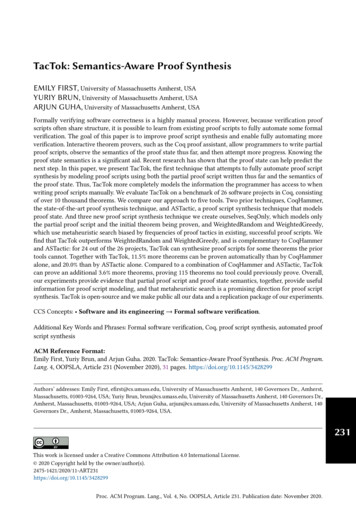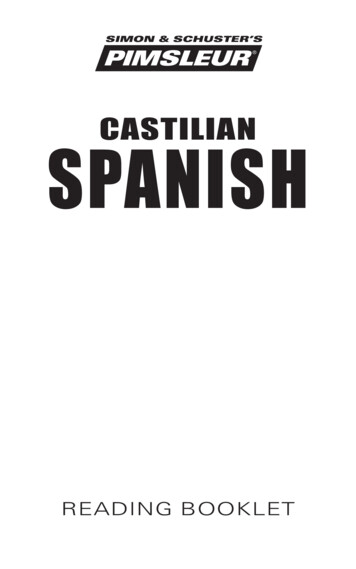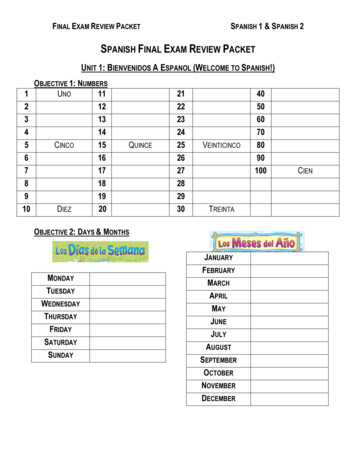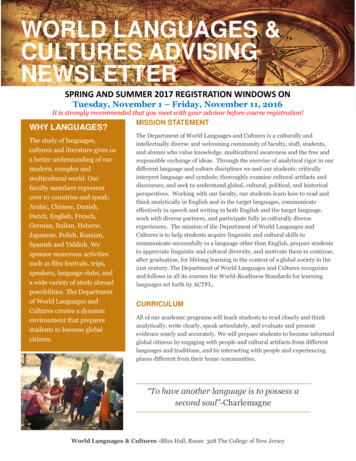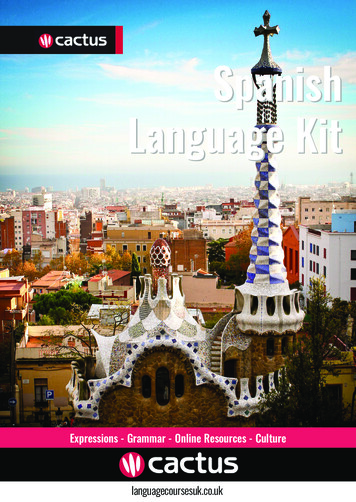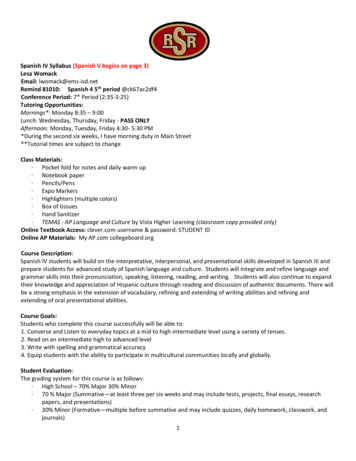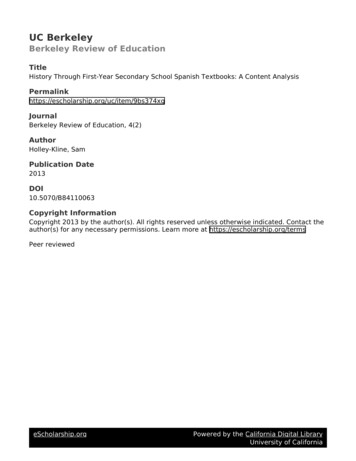
Transcription
UC BerkeleyBerkeley Review of EducationTitleHistory Through First-Year Secondary School Spanish Textbooks: A Content 9bs374xgJournalBerkeley Review of Education, 4(2)AuthorHolley-Kline, SamPublication Date2013DOI10.5070/B84110063Copyright InformationCopyright 2013 by the author(s). All rights reserved unless otherwise indicated. Contact theauthor(s) for any necessary permissions. Learn more at https://escholarship.org/termsPeer reviewedeScholarship.orgPowered by the California Digital LibraryUniversity of California
Available online at http://escholarship.org/uc/ucbgse breHistory Through First-Year Secondary School SpanishTextbooks: A Content AnalysisSam Holley-Kline1Stanford UniversityAbstractAlthough enrollments in secondary school Spanish have risen over the past few decades, theSpanish-speaking world (Latin America, in particular) tends to be underrepresented or absent inhistory textbooks. Given that not all students who take entry-level Spanish classes will continue tomore advanced levels, the first-year Spanish textbook may be some students’ first or onlyengagement with the histories of the Spanish-speaking world. Using content analysis, I evaluatefour entry-level secondary school Spanish textbooks for the nations they include, the time periodsthey reference, and the ways in which those references are made. My analysis indicates that manynations, time periods, and concepts are excluded, resulting in reductionist views of history. Thehistories referenced tend to be exoticized, resulting in the Othering of contemporary groups.Further approaches are suggested.Keywords: Spanish textbooks, historiography, textbook studies, secondary education, contentanalysisWhere do the United States’ secondary school students learn about the histories ofthe Spanish-speaking world? History classes would seem the most logical place, butprevious studies of history textbooks have found their coverage of Latin America—theregion home to most native speakers of Spanish—lacking. For example, Salvucci (1991)found that not one of the ten textbooks she evaluated “sustain[ed] its occasionallysuccessful treatment” (p. 213) of Mexican history. Commeryas and Alvermann (1994) aswell as Greenfield and Cortés (1991) found problems in the coverage of Latin Americanhistories in general, with the latter asserting that “in [world history] courses, once the ageof European exploration has passed, Latin America virtually disappears from history” (p.289). Even in undergraduate world history textbooks, “Latin America barely enters thenarrative” (Besse, 2004, p. 411). Furthermore, such criticisms are not new: VitoPerrone’s 1965 study of primary- and secondary-school textbooks finds fault with theresultant student understandings of Latin American culture and history (as cited in Meier,1969).Such deficiencies are coupled with growing enrollments in Spanish courses. Forexample, in the 29 years between Perrone’s 1965 study and that of Commeryas and1Correspondence concerning this article should be addressed to: Sam Holley-Kline, Department ofAnthropology, Main Quad, Building 50, Stanford University, Stanford, California 94305.Email: samhk@stanford.eduBerkeley Review of EducationVol. 4 No. 2, pp. 221-240
222Holley-KlineAlvermann, Spanish enrollments increased from 12.3% to 27.2% of all public schoolstudents in the United States (Draper & Hicks, 2000). This trend does not appear to beweakening: in 2008, of the roughly 91% of secondary schools in the United States thatoffered a foreign language, 93% of them offered Spanish (Rhodes & Pufahl, 2010). AsDraper and Hicks (2000) assert, “Spanish continues to dominate language instruction inthe United States” (p. 1). However, enrolling in introductory Spanish classes does notensure that students will continue with the language, either in secondary school (e.g.,Speiller, 1988) or college (e.g., Alonso, 2007). As Pratt, Agnello, and Santos (2009) note,most students study the language for two years or fewer in secondary school. Aftersecondary school, not all students of Spanish will enroll in college, and those that do maynot enroll in Spanish courses; for example, surveys conducted by Pratt (2010) indicatedthat only 39% of secondary school Spanish students sampled intended to continuestudying the language in college. In sum, then, the fact that more and more secondaryschool students take Spanish but do not necessarily continue it—coupled with the factthat that history textbooks do not adequately address Latin America—means thatintroductory-level secondary school Spanish courses constitute many students’ onlyengagement with Spanish and Latin American history.It therefore becomes important to understand, in greater detail, how historyis addressed in the entry-level Spanish language textbooks used in secondary schools. Tothat end, I evaluate depictions of the past in four such textbooks. Although I do not arguethat Spanish language textbooks should double as Latin American history textbooks, theirability to depict history authoritatively, given the relative lack of corresponding contentin history courses, makes such representations worth analyzing. Furthermore, as I willargue, their depictions of the past have consequences for understandings of both LatinAmerican history and modern peoples.The study involves three research questions about these representations: Incommonly used entry-level Spanish textbooks, (a) which nations’ histories arereferenced, (b) what time periods are referenced, and (c) how are the references made?Using content analysis, I find that history, as depicted in the textbooks sampled, ismarked by trends of exclusion and exoticism; the resulting views of history arereductionist for the past and Othering in the present.Literature ReviewTextbooks are the largest purveyor of course content in many classrooms (Ramirez &Hall, 1990) and are authoritative. As Kramsch (1988) notes, the idea that a textbookcould have errors is unthinkable for most students. Furthermore, as Provenzo, Shaver,and Bello (2011) note, “any textbook becomes a signpost or a marker for the values andbeliefs of the era in which it was written” (p. 1). As a result, it is unsurprising thathundreds of textbook studies have been conducted. In this section, I will focus on studiesof representations of history and culture in language and history textbooks. Although thetextbooks studied have changed over time, certain themes reappear across studies. Theseinclude the omission of historical events and conflict as well as emphases on lightskinned, middle-class experiences.Before addressing these themes, it is important to discuss the analytical distinctionbetween history and culture present in this paper. Previous studies of cultural topics in
History Through First-Year Secondary School Spanish Textbooks223Spanish textbooks have not made such a distinction. Their methods and objectives aresuch that distinguishing between depictions of the past and representations of the presentis unnecessary, or their definitions of culture implicitly include history. For example,Elissondo (2001) defines culture as “a complex space of practices and significationsconstructed by people in their struggles to make their voices heard in the social space” (p.72). In their study of business Spanish textbooks, Grosse and Uber (1992) define cultureas “patterns of everyday living and business/economic culture that pertain to a particularHispanic group or country” (p. 224). By contrast, Azripe and Aguirre (1987) intentionallyleave the term undefined. The authors of these studies of Spanish textbooks definedculture very differently, but in ways that enable them to evaluate representations ofhistory if they so chose. For example, Azripe and Aguirre (1987) find inaccuratehistorical information in some of the 18 textbooks they evaluated. Others, like Grosse andUber (1992), do not explicitly include historical content in their analyses. As a result,studies of “culture” as such analyze representations of the past and present.In this study, however, I examine history and not culture. Because culture is lessrelevant to this study, I leave the term undefined. I define history below, in the Methodssection. I do not intend to create a false history/culture dichotomy or to simply equate“the past” with “history” and “the present” with “culture.” Indeed, the relationshipbetween the two concepts is more complex: the depiction of history in the present bothinfluences and reflects the ways in which we view other modern cultures (Trouillot 1995;Vinall 2012), and culture affects the ways in which history is represented and understood(Sahlins, 2004). By separating culture and history and defining this study’s focus as thelatter, I emphasize that this study deals with the depiction of past events, peoples, andplaces as opposed to depictions of modern ethnic groups (Azripe & Aguirre, 1987) orissues of race, class, and ethnicity (Elissondo, 2001). In that way, this study is morerelated to studies of history textbooks than the aforementioned studies of languagetextbooks.History and Culture in Spanish TextbooksWhile many previous studies do not separate culture and history, the trends they findin cultural depictions often apply to historical representations. Azripe and Aguirre (1987)find a sample of first-year undergraduate-level textbooks marked by inaccuracies,stereotypes, oversimplifications, and omissions. The authors found incorrect historicalstatements including, for example, a characterization of the conflict in which Cubanwriter and revolutionary José Martí died as an “unsuccessful rebellion” (Azripe &Aguirre, 1987, p. 126) rather than the successful War of Independence. Elissondo (2001),evaluating the visual content of three undergraduate-level Spanish textbooks, finds biasedperspectives in visual representations: most photos depict light-skinned, middle-classLatin Americans living in leisure and tranquility. Depictions of history reinforce thisperspective by focusing on the prevalence of European descendants in Argentina withoutexplaining the colonizing processes that enabled their prominence (Elissondo, 2001).Fewer authors have examined secondary school Spanish textbooks, but those whohave report similar deficiencies. Ramirez and Hall (1990) find that the five Spanishtextbooks they sampled omitted most countries of the Spanish-speaking world, Spanishspeaking groups in the United States, as well as mentions of conflict and social class.
224Holley-KlineAlthough they do not explicitly analyze historical representations, mentions of theircategory of “folklore/history” account for only around 5% of the cultural themes theyfound in the textbooks they sampled (p. 51). With the intention of updating Ramirez andHall (1990), Hermann (2007) analyzes four Spanish textbooks to determine relativecountry representations; themes derived from lessons, visuals, and dialogue; andrepresentations of people. She finds that “the implicit raison d’etre of language educationaccording to the photographic and cultural content demonstrated in these textbooksremains teaching students how to travel and shop in exotic vacation destinations” (p.131). Herman (2007) also finds “avoidance of discussion of societal-level issues thatmight aid teachers in . . . connecting to other course content in the students’ schoolexperience” (p. 125). The failure of Spanish textbooks to address social issues is not anew problem. In 1945, Arce found lack of attention to social conditions in seven Spanishtextbooks; although she included history in her analysis, it did not figure into herconclusions beyond suggestions that teachers should compensate for the deficiencies oftheir textbooks.The Spanish-Speaking World in History TextbooksThe Spanish-speaking world has more often been a topic of study in secondaryschool history textbooks than in Spanish-language textbooks. Salvucci (1991) evaluatesten secondary school history textbooks approved by the Texas Board of Educationbetween 1986 and 1992 for the ways in which they present Mexico, Mexicans, andMexican-Americans. While acknowledging that the textbooks sampled had improvedover earlier editions, she finds a neglect of pre-Hispanic cultures; one-sided accounts ofevents like the Texas Rebellion, French Intervention, and Mexican Revolution; and notreatment of post-Revolutionary Mexico. Greenfield and Cortés (1991) form similarconclusions from the depictions of Mexico in primary and secondary school textbooks:“The Mexican experience emerges mainly as a series of reactions to larger United Statesconcerns and as a series of phenomena that provoked the United States to respond” (p.290). Cruz (1994) corroborates this finding: “[For the most part, the Mexican-Americanand Spanish-American Wars are the only] two situations in United States history whereLatin Americans are mentioned and Latin America is studied to some degree” (p. 55).These studies of Spanish textbooks focus on the misrepresentation of culture,omission of conflict, and paucity of historical information, while studies of history focuson depictions of the past in history textbooks, marked frequently by patterns of exclusion.A missing link is the study of the historical content of Spanish-language textbooks.Recent research has begun to address this fault (e.g., Kramsch 2012). For example, Vinall(2012) evaluates an activity related to the historical legacy of the Conquest of theAmericas in an undergraduate-level Spanish textbook. The activity includes a photographof two tourists buying a purse from an indigenous woman, an explanation that suggeststhat suspicion towards foreigners is a legacy of the Conquest, and three questions aboutgetting to know people. In Vinall’s analysis, the activity essentializes the identities of thefigures in the photograph, reducing them to generic indigenous figures and Westerntourist figures. The purse, a fetishized object, emphasizes the commercial aspect of therelationship between the figures and masks a history of asymmetrical power relations.The result is that, rather than encouraging students to interrogate the legacy of the
History Through First-Year Secondary School Spanish Textbooks225Conquest, the textbook reinforces a single narrative: Indigenous people mistrustforeigners because of the Conquest. I share this concern with depictions of the past inSpanish-language textbooks, but I will focus on broad trends in the depiction of history insecondary school textbooks, as opposed to single, in-depth examples from undergraduateones.MethodsSamplingStrategies for sampling textbooks in previous studies have varied, given that textbookpublishers do not release sales numbers (Herman, 2007). For example, Ramirez and Hall(1990) polled eighteen secondary school Spanish teachers and their colleagues for thetextbooks they used, while Azripe and Aguirre (1987) consulted Books in Print andsubsequently requested their textbooks from publishers. In hopes of collecting arepresentative sample, I opted to follow Herman (2007) instead:A sales and marketing agent for one of the publishers . . . did privately estimateto me that, combined, these four textbooks represent something approaching80% of the market for high school Spanish students in the US. While it appearsdifficult or impossible to confirm such numbers, certainly the publishers of thetextbooks that I reviewed—i.e., Prentice Hall, McGraw-Hill, McDougal Littell,and Holt, Rinehart & Winston (and their international parent corporations)—represent the vast majority of high school textbook production for the US. (p.125-126)I then ordered, via interlibrary loan, the most recent editions possible of the textbooksHerman sampled (see Table 1).Table 1Textbooks Sampled in StudyTitle¡Buen viaje!AuthorsConrad J. SchmittProtase E. sate!Nancy HumbachSylvia Madrigal VelascoAna Beatriz ChiquitoStuart SmithJohn McMinn20081A/1B*Holt, Rinehart, andWinston¡En español!Estella GahalaPatricia Hamilton CarlinAudrey L. HeiningBoyontonRicardo OtheguyBarbara J. Rupert20041McDougal Littel
226Holley-KlineRealidadesPeggy Palo BoylesMyriam MetRichard S. SayersCarol Eubanks Wargin20111Prentice HallNote. All textbooks were teachers’ editions; however, the content directed at teachers was not considered inthe analysis.*Although A and B editions are targeted towards middle school, considering both together and excluding thebridge chapters yields the same content as a first-year secondary school textbook.Content AnalysisThis study employs qualitative content analysis, as defined by Hsieh and Shannon(2005): “a research method for the subjective interpretation of the content of text datathrough the systematic classification process of coding and identifying themes orpatterns” (p.1278). First, I generated three categories based on my research questions:national referent, time period referenced, and style of reference. The first category,national referent, was drawn from Herman (2007), while the latter two, time periodreferenced and style of reference, come from a distinction made by Trouillot (1995). Henotes that history, in its typical usage, has two meanings: “both the facts of the matter anda narrative of those facts” (p. 2). He labels the former historicity one and the latterhistoricity two. The coding of the time period to which the reference alludes addresseshistoricity one, “what happened,” while the coding of the way in which the reference ismade addresses the construction of historicity two, “that which is said to have happened”(Trouillot, 1995, p. 2). In other words, the aim is to understand both the historiespresented and how they are narrated.Second, I skimmed each textbook to locate and mark references to history. Historydenotes a textual reference to a defined past actor, event, or context that exists outside ofthe textbook, in English or Spanish (translations of references originally made in Spanishare mine). Thus, I counted “after conquering Tenochititlán in 1521, the Spanishconstructed their capital on top of the capital of the Aztecs” (Gahala, Carlin, HeningBoynton, Otheguy, & Rupert, 2004, p. 162) but excluded “last weekend, José, somefriends, and I went skiing” (Schmitt & Woodford, 2008, p. 284), because the latter refersto an event in a past that exists only in the textbook. Third, I generated a list of mutuallyexclusive codes for each category after a close reading of the located references. Fourth, Ireviewed the marked references and applied one code per category to each reference; inthe event that more than one code was necessary, a multiple category was used. Theresult was a table containing every historical reference, each described in terms of thenation to which it referred, the time period to which it referred, and the way in which itwas made. I will explain each of these categories and the codes they contain below.National referent. The national referent category was drawn from Herman (2007, p.145-146), with some modifications (specifically, the collapsing of distinctions betweenregions of the United States). I applied codes (e.g. “Mexico,” or “Ecuador”) in thiscategory based on the mention of a nation in the reference itself, or the context of thereference in the textbook section (often organized by country and theme). The termnation is used in its broadest sense here: “a people having a common origin, tradition,and language and capable of forming or actually constituting a nation-state”
History Through First-Year Secondary School Spanish Textbooks227(“nationality”, 2012). Thus, Puerto Rico, though legally a Commonwealth, was classifiedas a nation based on its distinction from the United States in the textbooks sampled. In afew instances, I could not assign national referents with confidence; they were coded asunspecified.Time period. To address the time periods referenced, I made a general chronology ofthe histories of the nations of the Spanish-speaking world and divided it into eras. Eachera served as a code, and on rare occasions, a reference involved multiple time periodsand was coded as multiple. Given the diversity of pre-Conquest chronologies in theAndes, Mesoamerica, and the Iberian Peninsula, it was necessary to correlate the datesand eras across the regions to establish the codes (see Table 2). A comprehensiveperiodization of pan-American and pan-Atlantic history is beyond the scope of this study,but it is important that the analytical foundations of the divisions in time be made explicit(Stearns, 1987). The historical and archaeological references for the divisions of the pre1492 chronology in the Andes, Mesoamerica, and the Iberian Peninsula are Shimada(1999), Balkansky (2006), and Rinehard and Seeley (1988), respectively; the last is alsoused for Spain after 1492.Table 2Explanation of Codes Applied in Time Period CategoryCodeChronologyArea: AndesPrehistoricTimeperiodDatesInitial rea:Iberian PeninsulaPre-IberianEarly Horizon –Early IntermediateFormativePre-Roman –Roman SpainDates1400 BCE-550CE900 BCE-300CE2000 BCE-484 CETimeperiodDatesMiddle HorizonClassic550-900 CE300-900 CEVisigothic –Moorish Spain484-1248 CETimeperiodDatesLate Intermediate– Late Horizon900-1532 CEPostclassicMedieval900-1520 CE1248-1492 CETimeperiodColonial periodDatesc. 1532-c. 182010,000-1400 BCE10,000-2000 BCECatholic Monarchs– Peninsular War
dent nationsDatesTimeperiodDatesc. 1820-c. 1900ModernityPeninsular War –Spanish-AmericanWarc. 1900-PresentI developed this periodization for analytical purposes. For example, I do not intend tocomment on the relative developments of medieval Spain and Mesoamerica under theAztec Empire by placing both in the Postclassic code, nor do I intend to say thatmodernity began in 1900 by associating the code of that name with that particular date.Style of reference. The style of reference category represents the narration of historyin the sampled textbooks. I found that history tended to be referenced in five main ways,which generated five corresponding codes: indeterminate, vague, relative, descriptive,and specific.Table 3Definitions of Codes Applied in Style of Reference CategoryCodeDefinitionIndeterminateReference to past without reference to timeVagueReference to past with ambiguous time markerRelativeReference to past by association with other past elementDescriptiveReference to past using name of time periodSpecificReference to past using specific year, decade, or centuryIndeterminate references were those that alluded to the past with no associated timemarkers. For example, in a section labeled “Masterworks of history,” the Spanish city ofÁvila is described as “a completely walled city” (Schmitt & Woodford, 2008, p. 464).The implication is that the city had been walled sometime in the past, but without anyreference to when. The historical present is also included in this category: “SimónBolivar and José de San Martín fight against Spain for the independence of the countriesof South America” (Schmitt & Woodford, 2008, p. 33). Given that many South Americancountries are currently independent, the fight to which the textbook refers must havehappened at some unspecified time in the past. Vague references were those that did marktime, albeit ambiguously. For example, the murals of the Classic Maya site of Bonampak,Chiapas, are described as “ancient Mayan murals preserved in an ancient building”
History Through First-Year Secondary School Spanish Textbooks229(Humbach, Velasco, Chiquito, Smith, & McMinn, 2008, p. 36). The reference makes noteof the fact that the murals are pre-Conquest, but does not reference a particular period.“Ancient” could mean Prehistoric or Classic. Relative references are those that establishthe timing of the event by alluding to another event. For example, a short description ofCuzco, Peru, notes that “the Spanish transformed the temples and palaces of the Inca intochurches and magnificent houses” (Schmitt & Woodford, 2008, p. 368) when Pizarroarrived and conquered the city. Alone, the cited reference would be indeterminate but thereference to Pizarro establishes a relative time frame for the event. Descriptive referencesare those that name time periods without dates. For instance, a reading on the Zócalo ofMexico City describes the Cathedral and Tabernacle as “religious symbols and importantexamples of the colonial architecture and art of Mexico” (Gahala et al., 2004, p. 162).The reference is to a certain era—the colonial—rather than some undefined time in thepast. Specific references are those that named particular centuries, decades, or years. Forinstance, “Carlos V of Spain first proposed a canal across the Isthmus of Panama in1524” (Boyles, Met, Sayers, & Wargin, 2011, p. 118).ResultsThe evaluation of results focused on trends, patterns, and themes, rather thanstatistical significance or hypothesis testing (Zhang & Wildemuth, 2009). Historicalreferences were sparse across all textbooks sampled; calculating the mean number ofhistorical references per page yielded a fractional result (see Table 4). The paucity ofhistorical references is not surprising; although I argued previously that entry-levelsecondary school Spanish textbooks are in a unique position to impart historicalknowledge, they devote much of their space to reading, writing, speaking, and listeningactivities.Table 4Total Pages, Historical References, and Mean Number of Such References by TextbookTitleRealidades¡Exprésate! *¡En español!¡Buen viaje!Number ofpages471477465489Number of pages withhistorical references153767986Mean number of historicalreferences per page.32.16.17.17*Excludes bridge chaptersAnalysis of code distribution within the national referent category reveals that withineach textbook, most historical references focused on a few nations, though the particularnations varied by source (see Figure 1). Historical references focused primarily onMexico and Spain across all four textbooks. ¡Exprésate! and Realidades featured theUnited States heavily, while ¡En español! also referenced Puerto Rico and ¡Buen viaje!,Peru.
230Holley-KlinePercentoftotalreferencesFigure 1. Top Three Nations by Percentage of Total References per Textbook (Note thatthe y-axis maximum is nespañol!¡Exprésate!TimePeriodFigure 2. Percentage of Historical References by Time Period and Textbook (Note thatthe y-axis maximum is 50%.)
History Through First-Year Secondary School Spanish Textbooks231According to the analysis of the time period code, textbooks referenced different timeperiods with similar frequency (see Figure 2). The modern and colonial time periods werereferenced most often, though ¡Buen viaje! referenced the Postclassic period morefrequently than the colonial period.In the style of reference category, specific historical references were the mostprevalent across all textbooks sampled (see Fig. 3). Indeterminate references were alsocommon, though the rates at which they were made differed relative to that of the specificreferences across textbooks. For example, in Realidades, 13% of references wereindeterminate, while 76% were specific. By contrast, in ¡Buen viaje!, 38% of referenceswere indeterminate and 42% were specific. Relative, vague, and descriptive referencesconstituted less than 10% of all references across all textbooks.Figure 3. Proportions of Different Styles of Referencing History by TextbookDiscussionExclusionFrom these data, two main themes emerge: exclusion and exoticism. Exclusionresults in reductionist views of history, while exoticism results in the Othering of moderngroups. In this context, exclusion has geographical, temporal, and conceptual dimensions.Geographical exclusion, or more frequent representation of some countries over others, iswell-established in the literature on secondary school Spanish textbooks. Ramirez andHall (1990) report that Mexico and Spain together had more depictions than all theSpanish-speaking countries of South America combined. Herman (2007) reports that her
232Holley-Klinesample adopts a “kaleidoscope approach” (p. 128), purposely representing countries otherthan Mexico and Spain (although both are still prominent). Depictions of the past followthis kaleidoscope approach. As Figure 1 indicates, the top three nations referenced variedby textbook. However, Herman’s (2007) critique of the aforementioned method alsoapplies here: “[The kaleidoscope] approach risks trivializing those countries givenminimal treatment and may have the unintended consequence of conveying the idea thatthose countries are primarily of interest for their local color” (p. 128). As a result, thehistory of the Spanish-speaking world becomes mainly the history of a few differentnations, which vary by textbook (see Figure 1): Mexico, Spain, the United States, Chile,Peru, and Puerto Rico.Excluding certain nations, however, could allow for more in-depth examination ofothers (Herman, 2007). If geographical exclusion permits a stronger emphasis on a fewcountries, then we would expect historical components to have the depth necessary tojustify such exclusions, assuming the textbooks aim for a balance of historical breadthand depth. For example, we might expect that a textbook that neglects the colonial historyof two nations would focus on the entire history of a third nation, from the pre-Hispanicto the modern eras. While assessing textbooks’ historical depth requires a close readingof the texts themselves, evaluating the number of historical references per time period bynation is illustrative: acknowledging that a nation (or geographical region) has historybefore the present is an initial step towards depth.2 However, a review of the temporaldimension of exclusion, in which certain time periods are disproportionately referenced,
that Spanish language textbooks should double as Latin American history textbooks, their ability to depict history authoritatively, given the relative lack of corresponding content . (2011) note, "any textbook becomes a signpost or a marker for the values and beliefs of the era in which it was written" (p. 1). As a result, it is .
